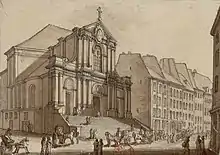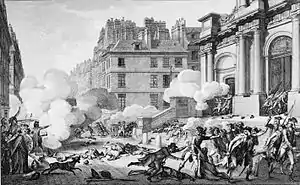Saint-Roch, Paris
The Church of Saint-Roch (French: Église Saint-Roch) is a late Baroque 126 meter-long church in Paris, dedicated to Saint Roch. Located at 284 rue Saint-Honoré, in the 1st arrondissement, it was built between 1653 and 1740.[2]
| Saint-Roch, Paris | |
|---|---|
 Saint-Roch | |
| Religion | |
| Affiliation | Catholic Church |
| Province | Archdiocese of Paris |
| Region | Île-de-France |
| Rite | Roman Rite |
| Status | Active |
| Location | |
| Location | 284 Rue Saint-Honoré, 1e |
| State | France |
| Geographic coordinates | 48°51′55″N 2°19′57″E |
| Architecture | |
| Type | Parish church |
| Style | Baroque |
| Groundbreaking | 1653 |
| Completed | 1722 |
| Direction of façade | South |
| Official name: Eglise Saint-Roch | |
| Designated | 1914 |
| Reference no. | PA00085798[1] |
| Denomination | Église |
| Website | |
| www | |
The church is organized as a series of chapels. One of them is dedicated to Saint Susanna in memory of the church which used to stand in its place. Accordingly, there is a mural painting above the altar, showing Saint Susanna fleeing her attackers, and looking up to the heavens for the help of God.
| Located near the Métro station: Pyramides. |
History
In 1521, the tradesman Jean Dinocheau had a chapel built on the outskirts of Paris, which he dedicated to Saint Susanna. In 1577, his nephew Etienne Dinocheau had it extended into a larger church. In 1629, it became the parish church and thereafter underwent further work. The first stone of the church of Saint-Roch was laid by Louis XIV in 1653, accompanied by his mother Anne of Austria. Originally designed by Jacques Lemercier, the building's construction was halted in 1660 and was resumed in 1701 under the direction of architect Jacques Hardouin-Mansart, brother of the better-known Jules Hardouin-Mansart. Work was finally completed in 1754.
At the time of the French Revolution, the church of Saint-Roch was often at the centre of events and was the scene of many shootings which have left their mark on the façade. 13 Vendémiaire was one such occasion, this was pivotal in the rise of Napoleon. It was not only the outside of the church that was damaged. During the Revolution it was ransacked, and many works of art were stolen or destroyed.
Historic images of Saint-Roch
 The church in the early 1800s
The church in the early 1800s The Journée of 13 Vendémiaire, Year 4
The Journée of 13 Vendémiaire, Year 4 Chapel of St. Susanna (1710)
Chapel of St. Susanna (1710)
Present-day images of Saint-Roch
Notable people
The church contains the memorials of Denis Diderot, the Comte de Grasse, Baron d'Holbach, Henri de Lorraine-Harcourt, the playwright Pierre Corneille, André le Nôtre, Marie-Thérèse Rodet Geoffrin and Marie Anne de Bourbon, daughter of Louis XIV, and Claude-Adrien Helvétius. In 1791, several tombs were relocated from the Couvent des Jacobins, Saint-Honoré when it was taken over by Jacobin Club; they included that of the soldier François de Créquy (1629-1687), designed by Charles Le Brun and executed by Antoine Coysevox, and the painter Pierre Mignard (1612-1695).[3]
Other notable burials included César de Vendôme (1664), René Duguay-Trouin (1736), Claude-Adrien Helvétius (1771), and Jean-Honoré Fragonard (1806), while the Marquis de Sade, the Marquis de Lafayette and Vauban were among those married in this church.[4]
After the failed November 1830 Polish Uprising, Saint-Roch became known as the 'Polish church' due to the many exiles who attended service there; they included Chopin (1810-1849), who allegedly composed a Veni Creator prayer he played on the church organ during Mass.[5]
On 18 November 1880 Prince Roland Bonaparte and Marie-Félix Blanc were married at the church.
In 1825 a mass composed by Hector Berlioz was performed at the church.
References
- Mérimée database 1993
- Blackmore, Ruth (2012). The Rough Guide to Paris. London: Rough Guides. p. 71. ISBN 978-1405386951.
- "Francois de Crequy". Findagrave.com. Retrieved 22 January 2019.
- Morgan, George (1919). The True LaFayette. Lippincott.
- Szulc, Tad (1998). Chopin In Paris: The Life and Times of the Romantic Composer (1999 ed.). Da Capo Press. p. 332. ISBN 978-0306809330.
External links
| Wikimedia Commons has media related to Église Saint-Roch de Paris. |
- Website (in French)
- Structurae
- Description of the church (in French)
_(2).jpg.webp)
_(1).jpg.webp)

(Plaphon)(PA00085798).jpg.webp)